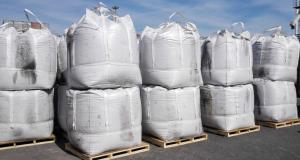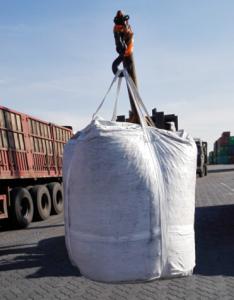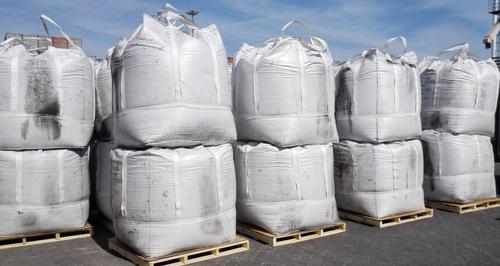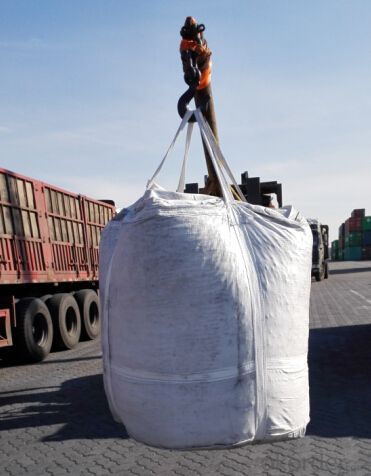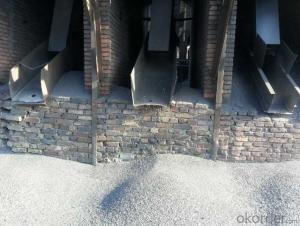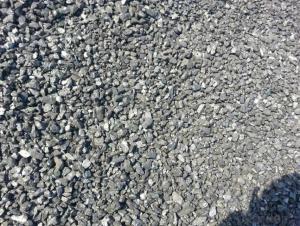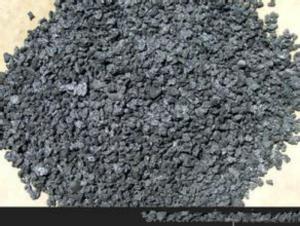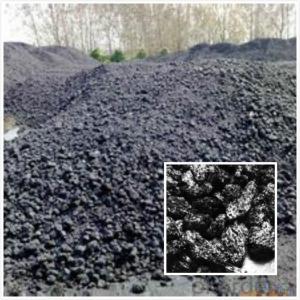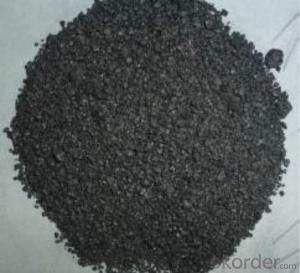Petroleum Coke Type High FC Carbon Additive
- Loading Port:
- Tianjin
- Payment Terms:
- TT or LC
- Min Order Qty:
- 20 m.t.
- Supply Capability:
- 1500 m.t./month
OKorder Service Pledge
OKorder Financial Service
You Might Also Like
Quick Details
Place of Origin: China (Mainland)
Application: carben additives
Dimensions: fix carben morethan98%,sulphur less5%
Chemical Composition: nature graphite powder
attribute: briquette grade
shape: <SPAN style="BORDER-BOTTOM: 0px; BORDER-LEFT: 0px; PADDING-BOTTOM: 0px; MARGIN: 0px; PADDING-LEFT: 0px; PADDING-RIGHT: 0px; FONT-FAMILY: inherit; WORD-WRAP: break-word; VERTICAL-ALIGN: baseline; BORDER-TOP: 0px; BORDER-RIGHT: 0px; PADDING-TOP: 0px" class=attr-value title=block/powder>block/powder
classify: carbon additives/petroleum coke
Packaging & Delivery
| Packaging Details: | 50kg/bag,25kg/bag or as customer requirement |
|---|---|
| Delivery Detail: | 20DAYS after payment |
Specifications
Petroleum Coke Type High FC Carbon Additive
Petroleum coke products can be divided into needle coke, sponge coke, projectile coke and coke breeze four kinds.
Calcined Petroleum Coke
F.C.: 98.5%MIN
ASH: 0.8% MAX
V.M.: 0.7%MAX
S:0.5%MAX
Moisture: 0.5%MAX
Structure
Petroleum Coke Type High FC Carbon Additive
Shape: granule
- Dimensions: 0-1mm, 1-5mm, 1-6mm, 2-8mm, etc
- Product Type: Carbon Additive
- C Content (%): 98-99.5% MIN
- Working Temperature: -
- S Content (%): 0.5%-0.7%MAX
- Ash Content (%): 0.7%MAX
- Volatile:0.8%MAX
- Moisture: 0.5% MAX
- ADVANTAGE: low ash & sulfur
- COLOR: Black
Feature
Petroleum Coke Type High FC Carbon Additive
Physics and chemistry performance :
Unit | Index | |||||
No.1 | No.2 | No.3 |
| |||
Density | g/cm3 | 2.04 | 2.00 | 2.00 | ||
sulphur content | %≤ | 0.5 | 1.0 | 2.5 | ||
volatility | %≤ | 0.5 | 0.5 | 0.5 | ||
ash content | %≤ | 0.5 | 0.5 | 0.5 | ||
moisture | %≤ | 0.3 | 0.5 | 0.5 | ||
charcoal | %≤ | 98.5 | 98.0 | 98.0 | ||
Image
Petroleum Coke Type High FC Carbon Additive


FAQ:
Petroleum Coke Type High FC Carbon Additive
How to classify calcined petroleum coke?
1) According to difference of sulfur content, can be divided into high sulfur coke (sulfur content more than 4%), sulphur in coke sulfur content (2% 4%) and low sulfur coke (sulfur content below 2%).
2) Petroleum coke products can be divided into needle coke, sponge coke, projectile coke and coke breeze four kinds:
3) Needle coke, has obvious needle-like structure and fiber texture, mainly used for steel-making in high power and ultra-high power graphite electrode. As a result of needle coke in sulfur content, ash content, volatile matter and true density and so on have strict quality requirements, so the production process of needle coke and raw materials have special requirements.
4) The sponge coke, high chemical reactivity, low content of impurities, mainly used in the aluminum industry and carbon industry.
5) Focal or spherical coke: the projectile shape is round, diameter 0.6-30 mm, usually from the production of high sulphur, high asphaltic residual oil, can only be used as industrial fuel power generation, cement etc.
6) Coke breeze: fluidized coking process, the fine particles (0.1- 0.4 mm) in diameter, high volatile, high expansion coefficient, cannot be directly used for electrode preparation and carbon industry.
Advantage:
Petroleum Coke Type High FC Carbon Additive
1. High quality and competitive price.
2. Timely delivery.
3. If any item you like. Please contact us.
Your sincere inquiries are typically answered within 24 hours.
- Q: Is graphite carbon?
- Chemically, it belongs to carbonWhen these carbon atoms connect with each other to form a single substance, they have different ways.
- Q: How does carbon dioxide contribute to ocean acidification?
- Ocean acidification is caused by the presence of carbon dioxide, which forms carbonic acid when it dissolves in seawater. This reaction results in an increase in hydrogen ions and a decrease in pH, making the water more acidic. Human activities, especially the burning of fossil fuels, are leading to a rise in carbon dioxide emissions. As a result, more carbon dioxide is being absorbed by the oceans, disrupting the natural balance between atmospheric and oceanic carbon dioxide levels. This excess absorption leads to an accumulation of carbon dioxide in the seawater. The increased acidity of the seawater poses a significant threat to marine life. Many organisms, such as corals, shellfish, and certain types of plankton, rely on calcium carbonate to construct their shells or skeletons. However, in more acidic water, the availability of carbonate ions, necessary for calcium carbonate formation, decreases. Consequently, these organisms struggle to build and maintain their protective structures, rendering them more susceptible to predation and other dangers. Ocean acidification also has adverse effects on the growth, development, and behavior of numerous other marine species. For example, it can disrupt fish reproductive cycles and alter the behavior of certain species, making them more vulnerable to predators or adversely affecting their ability to locate food or mates. Moreover, ocean acidification can trigger a chain reaction that impacts entire marine ecosystems. The interconnectedness of species in complex food webs means that any disturbance to one species can have far-reaching consequences for others. If the population of a particular fish species declines due to acidification, it can have a ripple effect on the entire food chain, influencing the abundance and distribution of other species. In conclusion, the process of ocean acidification occurs as carbon dioxide dissolves in seawater and forms carbonic acid, resulting in an increase in hydrogen ions and a decrease in pH. This process has detrimental effects on marine organisms, particularly those reliant on calcium carbonate for their shells or skeletons. It also disrupts the growth, development, and behavior of various marine species and can have cascading impacts on entire ecosystems.
- Q: Where do I buy DNF premium advanced carbon?
- Seems to be in the mall in the wish gift box, oh, do not remember, I do not know, is not it?! Look, I haven't played that game for a long time. I hope I can help you
- Q: How can I see if a battery can be used to recharge it?Can not all carbon batteries charge?
- Final conclusion:Carbon batteries, alkaline batteries are not charged, the voltage is 1.5V, nickel cadmium batteries, nickel hydrogen batteries can charge voltage 1.2VPay special attention to the risk of leakage or explosion if you charge to a carbon battery or alkaline battery
- Q: What materials can be carbonitriding?
- Low temperature carbonitriding for high alloy tool steel, high-speed steel tools, etc., in temperature carbonitriding is under great pressure not only in carbon steel wear parts, high temperature carbonitriding is mainly used for medium carbon steel and alloy steel under great pressure.
- Q: What are the long-term effects of increased carbon emissions on ecosystems?
- Ecosystems are significantly impacted by the increase in carbon emissions, with climate change being one of the most notable consequences. Carbon dioxide, a greenhouse gas, traps heat in the atmosphere and leads to rising temperatures, changes in weather patterns, and more frequent and intense extreme weather events like hurricanes, droughts, and wildfires. These climate changes have numerous negative effects on ecosystems. For example, the rising temperatures directly affect the behavior and physiology of plants and animals. Many species have specific temperature requirements for their survival, feeding, and reproduction. Even slight changes in temperature can disrupt their life cycles, causing population declines or even extinctions. Moreover, the increase in carbon emissions contributes to ocean acidification. This process occurs when excess carbon dioxide in the atmosphere dissolves in seawater, forming carbonic acid. The acidification has devastating consequences for marine ecosystems, especially for coral reefs and shell-forming organisms such as oysters and clams. It weakens their structures made of calcium carbonate and hinders their growth and reproduction, ultimately leading to their decline. Furthermore, carbon emissions influence the distribution and composition of plant communities. Carbon dioxide is essential for photosynthesis, and elevated levels can enhance plant growth and productivity. However, this can also result in changes in plant composition and the competitive balance between species, favoring certain fast-growing species at the expense of others. This disruption can impact the intricate relationships between plants, pollinators, herbivores, and other organisms, affecting the entire food web. Additionally, increased carbon emissions contribute to the loss of biodiversity. Many species are highly specialized and adapted to specific environmental conditions. As habitats change due to climate change, some species may struggle to adapt or find suitable alternatives, leading to declines or local extinctions. This loss of biodiversity can have cascading effects throughout ecosystems, disrupting ecological processes and reducing the resilience and stability of entire ecosystems. In conclusion, the increase in carbon emissions has far-reaching and harmful long-term effects on ecosystems. It causes climate change, ocean acidification, alters plant communities, and drives biodiversity loss. It is crucial to reduce carbon emissions and mitigate climate change in order to protect and preserve the health and functioning of ecosystems for future generations.
- Q: What are the implications of melting permafrost on carbon emissions?
- The melting of permafrost has significant implications on carbon emissions. Permafrost contains large amounts of organic matter, such as dead plants and animals, which have been frozen and stored for thousands of years. When permafrost thaws, this organic matter decomposes and releases carbon dioxide and methane, two potent greenhouse gases. These greenhouse gases further contribute to global warming, exacerbating climate change. Additionally, the release of carbon from melting permafrost creates a positive feedback loop, as increased global temperatures lead to more permafrost thawing, causing even more carbon emissions. This highlights the urgent need to address permafrost melting as part of efforts to mitigate climate change.
- Q: How does carbon affect the formation of wildfires?
- Carbon does not directly affect the formation of wildfires, but it plays a crucial role in their intensity and duration. Carbon is a key component of organic matter, such as vegetation and dead plants, which serve as fuel for wildfires. When a wildfire occurs, the heat causes the carbon in these fuels to combine with oxygen, resulting in the process of combustion. This combustion releases energy in the form of heat, light, and gases, including carbon dioxide (CO2) and carbon monoxide (CO). The presence of carbon-rich fuels significantly contributes to the spread and intensity of wildfires. Dry and dead vegetation, often referred to as fuel loads, are highly flammable and allow fires to rapidly spread. Additionally, the carbon content in these fuels determines the amount of energy released during combustion. Consequently, the more carbon-rich the fuel, the more intense the fire will be. Moreover, the combustion of carbon during wildfires releases significant amounts of carbon dioxide into the atmosphere. Carbon dioxide is a greenhouse gas, which traps heat in the Earth's atmosphere and contributes to the greenhouse effect, leading to global warming. Increased levels of carbon dioxide in the atmosphere exacerbate climate change, further influencing the frequency and severity of wildfires. In summary, carbon indirectly affects the formation of wildfires by serving as fuel for combustion. The carbon content in vegetation and dead plants determines the intensity and spread of wildfires, while the release of carbon dioxide during combustion contributes to the long-term impact of wildfires on climate change.
- Q: How does carbon impact the prevalence of floods?
- Flood prevalence is not directly affected by carbon, but its role in influencing climate change is crucial, as it can impact the occurrence and severity of floods. Carbon dioxide (CO2), a greenhouse gas, primarily traps heat in the Earth's atmosphere, resulting in global warming. This global temperature increase has various consequences, including an escalation in extreme weather events like floods. As the Earth warms, the atmosphere can hold more moisture, increasing the likelihood of heavy precipitation events. This leads to more intense rainfall, causing rivers and water bodies to overflow and causing floods. Additionally, warmer temperatures can contribute to the melting of glaciers and ice caps, raising sea levels and intensifying the impact of floods, especially in coastal regions. Moreover, human activities such as burning fossil fuels and deforestation are the primary drivers of climate change, leading to carbon emissions. By reducing our carbon footprint and transitioning to cleaner energy sources, we can help mitigate the effects of climate change and potentially decrease flood prevalence in the long run. It's important to note that although carbon emissions significantly contribute to climate change, floods are not solely caused by them. Other natural factors, such as rainfall patterns, topography, and land use, also have important roles in determining flood risks.
- Q: What are the different types of carbon-based air pollutants?
- Air pollution is caused by various types of carbon-based pollutants. Some examples include: 1. Carbon Monoxide (CO): This gas is produced when fossil fuels like gasoline, coal, and wood are incompletely burned. It is highly toxic and can be harmful to human health, especially when inhaled in large amounts. 2. Carbon Dioxide (CO2): This is a greenhouse gas that occurs naturally in the Earth's atmosphere. However, human activities like burning fossil fuels and deforestation have significantly increased its levels, leading to climate change and global warming. 3. Volatile Organic Compounds (VOCs): These are organic chemicals that easily evaporate at room temperature. They are released into the air by various sources such as paints, solvents, gasoline, and industrial processes. VOCs contribute to the formation of ground-level ozone, which is a major component of smog and can harm human health. 4. Methane (CH4): Another greenhouse gas, methane is primarily produced by the decomposition of organic materials in landfills and the extraction and transportation of natural gas. Methane has a much higher warming potential than carbon dioxide. 5. Polycyclic Aromatic Hydrocarbons (PAHs): These chemicals are formed when organic materials like coal, oil, and gas are incompletely burned. PAHs are released into the air through vehicle exhaust, industrial processes, and the burning of fossil fuels. They are known to be cancer-causing and have adverse effects on human health. 6. Formaldehyde (HCHO): This colorless gas is used in the production of resins, plastics, and certain building materials and household products. It is released into the air through fuel combustion, cigarette smoke, and the release of certain products. Formaldehyde is a respiratory irritant and can cause allergic reactions and other health problems. These are just a few examples of carbon-based pollutants that contribute to air pollution. It is crucial to reduce emissions of these pollutants by adopting cleaner technologies, energy-efficient practices, and promoting the use of renewable energy sources. This will help minimize their negative impacts on human health and the environment.
Send your message to us
Petroleum Coke Type High FC Carbon Additive
- Loading Port:
- Tianjin
- Payment Terms:
- TT or LC
- Min Order Qty:
- 20 m.t.
- Supply Capability:
- 1500 m.t./month
OKorder Service Pledge
OKorder Financial Service
Similar products
Hot products
Hot Searches
Related keywords
